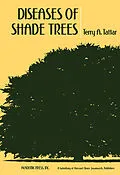Diseases of Shade Trees provides an introduction to tree diseases for students and others concerned with the care of shade and ornamental trees. Diseases of woody plants fall into two major categories: infectious diseases and noninfectious diseases. Part I of the book presents the infectious pathogens and the diseases they cause. These include bacteria, mycoplasmas, nematodes, seed plants, and viruses. The nature of the fungi is also presented, with separate chapters for leaf, root, rust, stem, and wilt diseases caused by fungi. Wound diseases, which are associated with both fungi and bacteria that invade wounds, are included in this section. Part II deals with noninfectious agents and the diseases they cause. Noninfectious agents are separated into environmental stress, animal injury, and people-pressure diseases. Diebacks and declines-complex diseases, which are often caused by a combination of both infectious and noninfectious agents are also included in this section. Part III on special topics includes discussions of nonpathogenic conditions often mistaken for diseases; diagnosis of tree diseases; and living hazard trees.
Inhalt
Preface
Acknowledgments
Part I Infectious Diseases
1 Introduction
Forest Trees versus Shade Trees
Tree Health Care
Categories of Shade Tree Diseases
2 The Fungi
Introduction
Nature of the Fungi
Identification of Fungi That Cause Tree Diseases
How Pathogenic Fungi Enter the Tree
How Fungi Cause Diseases in Trees
Conditions Favoring Disease by Fungi
3 Bacteria
Introduction
How Bacteria Cause Disease in Trees
Bacterial Diseases of Trees
Suggested References
4 Nematodes
Introduction
Plant Parasitic Nematodes
Life Cycle
How Nematodes Cause Tree Disease
Nematode Diseases of Trees
Reference
Suggested References
5 Viruses
Introduction
How Viruses Cause Tree Disease
Symptoms
Treatment
Virus Diseases of Trees
Virus Diseases of Ornamental Apples, Cherries, Peaches, Pears, and Plums
Suggested References
6 Mycoplasmas
Introduction
How Mycoplasmas Cause Tree Disease
Symptoms
Treatment
Mycoplasma Diseases of Trees
Other Common Mycoplasma Diseases of Shade Trees
Mycoplasma Diseases of Ornamental Apples, Cherries, Peaches, and Pears
Confusion of Virus and Mycoplasma Symptoms with Noninfectious Diseases
Suggested References
7 Seed Plants
Parasitic Seed Plants
Nonparasitic Seed Plants
Suggested References
8 Leaf Diseases
Introduction
Treatment
Some Common Leaf Diseases of Deciduous Hardwoods
Broad and Narrow-Leaved Evergreens
Some Common Evergreen Leaf Diseases
Insect Conditions Commonly Confused with Diseases
References
Suggested References
9 Stem Diseases
Introduction
Typical Life Cycle of Stem Disease Fungi
Treatment of Stem Diseases
Target Cankers
Diffuse Cankers
Canker Blight
Other Canker Diseases
Canker-Rots
Reference
Suggested References
10 Root Diseases
Introduction
Growth of Tree Roots
Mycorrhizae
Typical Life Cycle of Root Disease Fungi
Treatment of Root Diseases
Categories of Root Diseases
Some Examples of Root Diseases
References
Suggested References
11 Rust Diseases
Introduction
Typical Life Cycle of Rust Disease Fungi
Treatment of Rust Diseases
Canker Rusts
Gall Rusts
Leaf Rusts
Other Rust Diseases
References
Suggested References
12 Wilt Diseases
Introduction
Typical Wilt Disease Cycle
Typical Control of Wilt Disease
Wilt Diseases of Trees
Reference
Suggested References
13 Wound Diseases-Discoloration and Decay in Living Trees
Introduction
Wounds
Events after Wounding
Microbial Successions after Wounding
Wound Treatment
Other Conditions Resulting from Wounding
Sprout Clump Treatment
Reference
Suggested References
Part II Noninfectious Diseases
14 Introduction to Noninfectious Diseases
Some Common Basic Needs of Trees
What are Some Reasons for Prevalence of Noninfectious Disease?
General Symptomatology of Infectious and Noninfectious Diseases
Categories of Noninfectious Diseases
Suggested References
15 Temperature Stress
Introduction
High Temperature
Low Temperature
Containerized Ornamental Plants
Rapid Changes in Temperature
Reference
Suggested References
16 Moisture Stress
Introduction
Water Deficiency
Water Excess
Erosion
Physical Damage from Snow and Ice
Suggested References
17 Soil Stress
Introduction
pH (Degree of Acidity or Alkalinity)
Nutrient Deficiencies and Toxicities
Physical Condition of Soil
Root Girdling
Root Competition
Juglan Toxicity
Lightning Injury
References
Suggested References
18 Animal Injury
Introduction
Animal Wounds
Toxic Chemicals on Trees and Soil
Soil Compaction
Suggested References
19 Construction Injury and Soil Compaction
Introduction
Construction Injury
Prevention of Construction Injury
Soil Compaction
References
Suggested References
20 Injury from Chemicals, Electricity, and Artificial Light
Introduction
Chemical Injury
Electrical Injury
Injury from Artificial Light
References
Suggested References
21 Tree Maintenance
Introduction
Tree Planting
Follow-up Maintenance
Reference
Suggested References
22 Air Pollution
Introduction
Meteorology
Phytotoxic Gases
Particulates and Aerosols
Acidic Precipitation
Mimicking Symptoms
References
Suggested References
23 Diebacks and Declines-Complex Diseases
Introduction
Maple Decline
Oak Decline and Mortality
Ash Dieback
Other Complex Diseases
Conclusions
References
Suggested References
Part III Special Topics
24 Nonpathogenic Conditions
Introduction
Misinformation about Trees
Nonparasitic Organisms
Reference
Suggested References
25 Disease Diagnosis
Introduction
Diagnosis of Tree Disease in the Field
Diagnosis by Office Visit, Telephone, or Letter
Tools Used in Disease Diagnosis
Conclusions
Reference
Suggested References
26 Living Hazard-Trees
Introduction
Background
Categories of Hazardous Trees
Living Hazard-Trees and Their Detection
Suggested References
Glossary
Appendix I Common and Scientific Names of Ornamental Woody Plants
Appendix II Use of Pesticides
Appendix III Literature Containing Information about Shade Tree Diseases or Insects
Index
